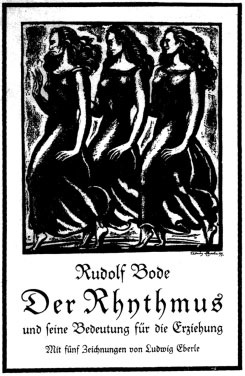This text has been translated and published by Paola Crespi in Body & Society, 2014, n° 20, pp. 51-74. It is also online on Academia.edu. We thank Paola Crespi for the permission to republish it here.
Abstract : Rudolf Bode’s text Rhythm and its Importance for Education (published by Eugen Diederich, Jena, 1920) has both a theoretical and a practical aim : to clarify the nature of the rhythm phenomenon in order to lay down the foundations of ‘Rhythmic Gymnastics’. Bode engages with the work of his contemporaries, such as Emile Jaques-Dalcroze, Karl Bücher and Ludwig Klages, and comes to identify rhythm with a continuum devoid of rationality. The text is unique in its ability to meaningfully connect such diverse fields as philosophy, gymnastics, anthropology and politics and shows, in this way, the potential of ‘rhythmanalysis’.
Keywords : 1920s, body, Germany, politics, rhythmanalysis, rhythmic gymnastics
The aim of the present work is twofold. First, it should help to remove
the serious ambiguity currently inherent in the word ‘rhythm’ that we
use so often ; this work should resolve a fundamental problem concealed
within the word. The second aim is more practical ; it should provide
a theoretical background to ‘rhythmic gymnastics’, a form of
education for young people that will become more prevalent than has
been possible until now. Part of this work has already been published,
before the war, in the pedagogical collection of essays of the Leipzig
Bugra, entitled : The Rhythmic Problem and the Jaques-Dalcroze
Method. This method has also been a subject of discussion since the
war, because from it, more than from any where else – so to say, ab origine
– has unfolded the activistic-mechanistic principle which marked
the previous decades and is no longer tenable in the future in Germany.
The essential content of this work counters this principle, as found in the
Jaques-Dalcroze method. However, other issues which could not be
developed further are also raised between the lines.
I would like to thank the sculptor Ludwig Eberle for his active participation
in my endeavours in the field of gymnastics ; I share his
conviction that the apparently insuperable boundaries dividing art
and physical education today will soon be a thing of the past.
[...]

